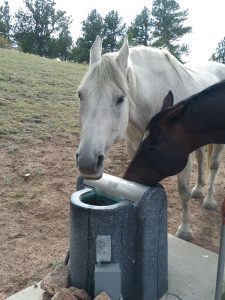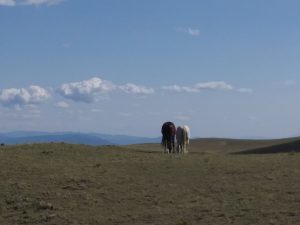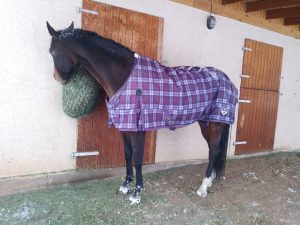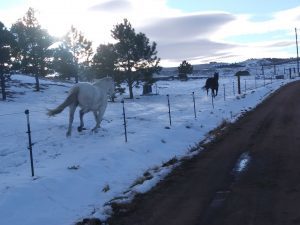Harper’s Lessons
Although we knew for months that sweet Moondo would not be with us much longer, I couldn’t face the prospect of looking for a new horse while he was alive.
I had no regrets about spending focused time with Moody in his final weeks, but if we were to continue to have horses in our lives, Jake would need a companion, so late July and early August were an unsettling mix. The raw emotions of loss were shadowed by brain-numbing online searches broken up with phone calls and emails punctuated by an occasional venture into the pandemic summer to look at prospects. I didn’t feel good about any of it. There could be no “replacing” Moondo, of course, but I’ve also never been a fan of getting on horses I don’t know. Then there’s the fact that looking for a horse is like the worst kind of blind dating, in which the one who turns out to be an asshole can dump you in the dirt.
I didn’t mean to, but I ended up buying the first horse I looked at. Not right away, not without seeing and riding other horses, and not without trying to talk myself out of it. But after a few weeks of looking, that first horse was the one I kept thinking about. The fact that Moondo, years ago, was also the first horse I looked at–that I had equivocated but eventually settled on him after seeing who else was out there–was a good omen, perhaps?
Harper is a ten-year-old dark bay quarter horse/thoroughbred cross with a sweet teardrop splotch on her forehead and a pair of ankle-high socks. She made a charming impression when I first approached her at the barn where she was living. I was slightly nervous and wondered what horses must think about people suddenly starting to wear masks over most of their faces. I offered my hand for her to sniff, which she did—and then proceeded to lick it very very…very…thoroughly. Very.
Under saddle out on the arena, she was attentive, businesslike, and a little huffy if my cues were awkward or over-strong: she would offer clear coaching if I hoped to revive my dressage skills. We took a short trail ride, during which she was calm, sensible, and interested in her surroundings. Rather than getting worked up about the crew thinning trees around the riding facility, she veered toward the tractor and snarling chainsaws, wanting to see what was going on.
Still, I waffled. I fretted about how Jake would act around a mare. I had reservations about bringing a barn-kept horse up to our rugged high-altitude setting. I worried about her little feet and those skinny super-model-long legs. Back problems had ended her career as a hunter/jumper. But she was sound for light riding, which is all I ever hope to do. The trainer overseeing her sale thought we were a good match, too, and insisted that Harper preferred turn-out to the stall. I looked at other horses, waffled some more. After going back and riding her a second time, personality won: I decided I’d be stupid to pass up such a sane and likeable horse.
When I brought Harper home a week later, she backed out of the trailer and stood assessing her surroundings for a few minutes, a slightly quizzical expression on her face. “What a strange-looking show grounds this is,” I imagined her thinking, “Where on earth are all the other horses??” We settled her in the barn pasture to start, letting her get a feel for the place before meeting Jake.
He’d been on his own for five weeks by then, and although he’d taken his isolation with admirable stoicism, he was transfixed to see her on the other side of the driveway and was no doubt excited to properly meet. We waited a few days and hoped the encounter would be uneventful, but a proper first meeting in the equine universe tends toward rude physicality. Curious nose-sniffing whirled to squealing and kicking in a millisecond. Jake landed a kick to Harper’s hindquarters with a heart-stopping thwack, but the impact was a slap against muscle and not a crack on bone. Harper did not accept the message that she would rank in second position with meek deference, gamely charging back at him butt-first.
With herd positions sorted—Jake on top but Harper drawing the line at how much shit she would take from him—the tone changed. Jake, in short, is besotted. Fortunately for household peace and for our vet bills, Harper appears to be pretty sweet on him, too. They’re both food-defensive, and bicker at feeding time, but have shown a surprising willingness to share resources, at least when the weather is mild. Out in the pasture, they hang out so close to one another it looks like they’re hitched together.
I’ve ridden some, but winter weather arrived early and then settled into repetitive freeze-thaw cycles with just enough snow thrown in to ensure a consistent abundance of ice. I’m at peace with not riding in the crummy conditions, though, and it’s not like Harper hasn’t been busy.
She’s been learning to cope with mountain weather, for starters, which started with a blizzard and nine inches of snow shortly after she arrived. She’s been working on growing her own winter coat, and now only wears her fashionista jacket when the weather is truly abysmal.
Jake has been showing her where to stand when the wind blows from what direction, and has persuaded her to try laying down in the snow. I’m not sure she’s convinced it’s worth it to get wet, but probably agrees that snowdrifts can actually be quite cushy.
Meanwhile, she’s been getting to know the neighbors…
…and has shown Jake who’s the fast horse on the place now.
Harper isn’t perfect—no horse is. To call her food-defensive is a nice way of saying she turns nasty when there’s food around, pinning her ears, swinging her head, snapping. She’s thin-skinned and touchy, and I’m still discovering her quirks, preferences, and less desirable behaviors. But the sensible and calm demeanor that attracted me hasn’t changed; every time I’ve gotten on Harper, I’ve ridden the same steady and businesslike horse.
And I continue to admire her boldness and curiosity. When I first turned her out in the big pasture, I took her on a walk to show her the loafing shed and the fences. When I turned her loose, she set off walking instead of joining Jake in grazing. She took a quick detour to investigate the braced corner of the cross-fence, but kept going, up the slope and out of the bowl that makes up most of the field. Jake followed without enthusiasm: he was ready to eat. From where I stood near the gate, I could see Harper pause atop the ridge, looking over the far fence. Then she headed out again, following the fenceline to the south.
The next morning, Doug reported that Jake was a little lethargic. We decided he wasn’t sick, just tired. Harper, I think, had worked through the night to map her new acreage. Unwilling to let his new beloved out of his sight, Jake had dutifully followed.
When I opened the gate into the winter pasture a month or so later, Harper did the same thing. She set off at purposeful march, not pausing until she could see the fence on the far side of the field. Satisfied she’d located the boundary, she dropped her head and started eating.
Like my old friend Moondo, Harper likes to know where she is, and now she’s home.












